1993 CADILLAC FLEETWOOD light
[x] Cancel search: lightPage 180 of 386
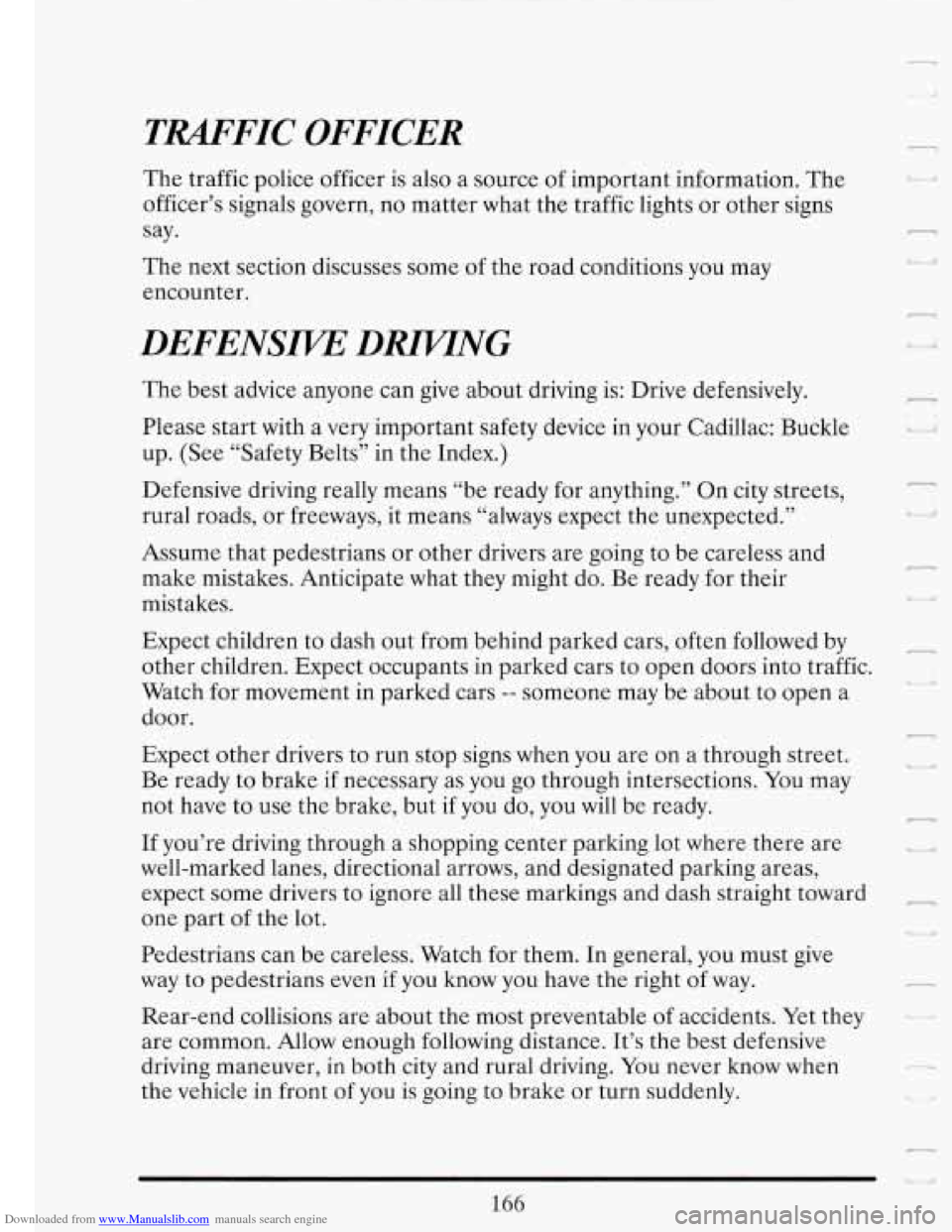
Downloaded from www.Manualslib.com manuals search engine TRAFFIC OFFICER 7 .. I: The traffic police officer is also a source of important information. The
officer’s signals govern, no matter what the traffic lights or other signs
say.
The next section discusses some of the road conditions you may
encounter.
DEFENSIVE DlUVTNG
The best advice anyone can give about driving is: Drive defensively.
Please start with a very important safety device
in your Cadillac: Buckle
up. (See “Safety Belts” in the Index.)
Defensive driving really means “be ready for anything.’’ On city streets,
rural roads, or freeways, it means “always expect the unexpected.”
Assume that pedestrians or other drivers are going to be careless and
make mistakes. Anticipate what they might do. Be ready for their
mistakes.
Expect children to dash out from behind parked cars, often followed by
other children. Expect occupants in parked cars to open doors into traffic.
Watch for movement
in parked cars -- someone may be about to open a
door.
Expect other drivers to run stop signs when you are on a through street.
Be ready to brake if necessary as you
go through intersections. You may
not have to use the brake, but
if you do, you will be ready.
If you’re driving through a shopping center parking lot where there are
well-marked lanes, directional arrows, and designated parking areas,
expect some drivers
to ignore all these markings and dash straight toward
one part of the lot.
Pedestrians can be careless. Watch for them. In general, you must give
way to pedestrians even if you know you have the right of way.
Rear-end collisions are about the most preventable of accidents. Yet they
are common. Allow enough following distance.
It’s the best defensive
driving maneuver,
in both city and rural driving. You never know when
the vehicle in front of you is going to brake or turn suddenly.
166
n
U i I‘
n
u
! I,
r
r
d
-
1
Page 182 of 386
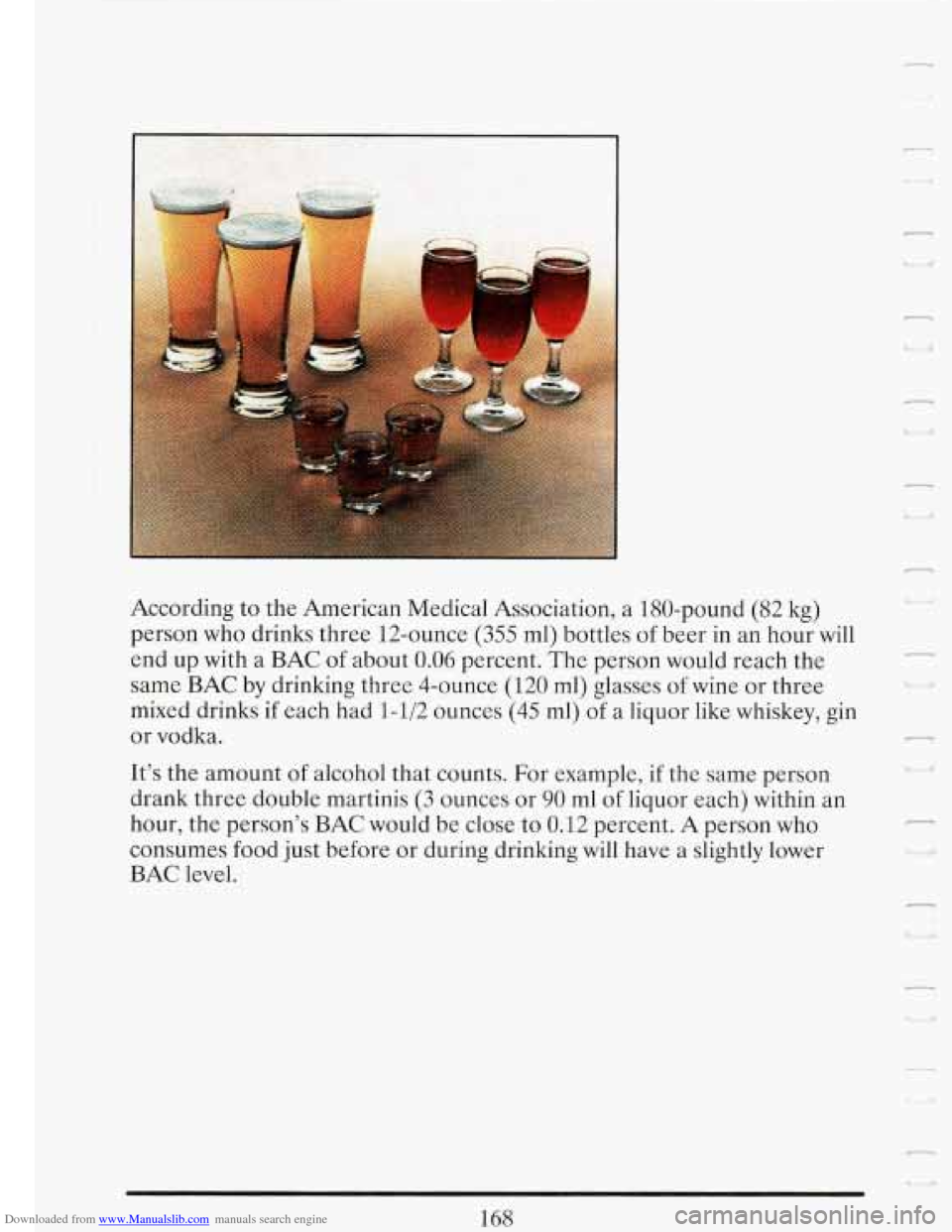
Downloaded from www.Manualslib.com manuals search engine According to the American Medical Association, a 180-pound (82 kg)
person who drinks three 12-ounce (355 ml) bottles of beer
in an hour will
end up with a
BAC of about 0.06 percent. The person would reach the
same
BAC by drinking three 4-ounce (120 ml) glasses of wine or three
mixed drinks if each had 1-1/2 ounces
(45 ml) of a liquor like whiskey, gin
or vodka.
r_
It's the amount of alcohol that counts. For example, if the same person
drank three double martinis (3 ounces or
90 ml of liquor each) within an
hour, the person's
BAC would be close to 0.12 percent. A person who
consumes food just before or during drinking
will have a slightly lower
BAC level.
168
Page 186 of 386
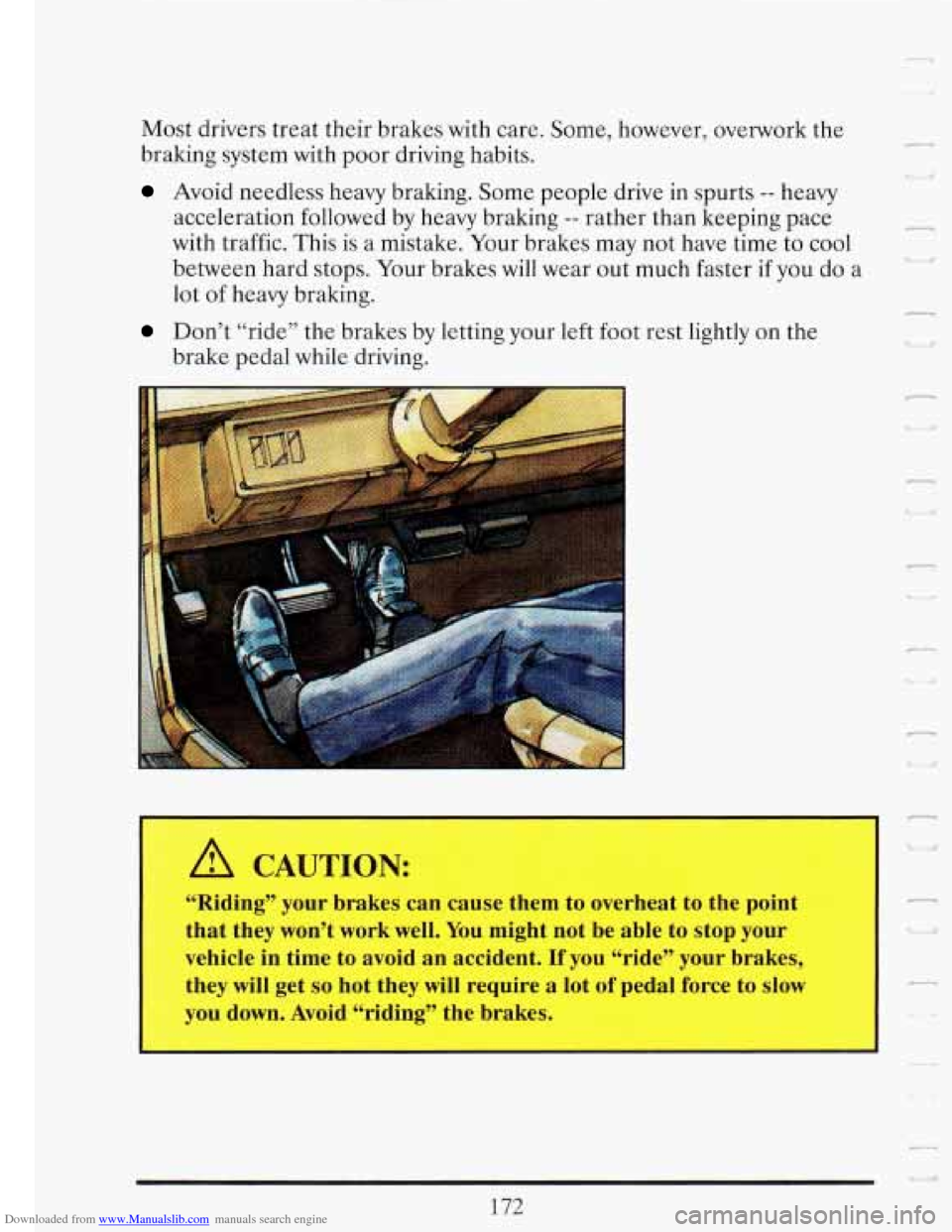
Downloaded from www.Manualslib.com manuals search engine Most drivers treat their brakes with care. Some, however, overwork the
braking system with poor driving habits.
Avoid needless heavy braking. Some people drive in spurts -- heavy
acceleration followed by heavy braking
-- rather than keeping pace
with traffic. This is a mistake. Your brakes may not have time to cool
between hard stops. Your brakes will wear out much faster
if you do a
lot of heavy braking.
Don’t “ride” the brakes by letting your left foot rest lightly on the
brake pedal while driving.
1 A CAUTION:
“Riding” your brakes can cause them to overheat to the point
that they won’t work well. You might not be able to stop your
vehicle in time to avoid an accident.
If you “ride” your brakes,
they will get
so hot they will require a lot of pedal force to slow
you down. Avoid “riding” the brakes.
172
n
I. - . il
L
Page 187 of 386
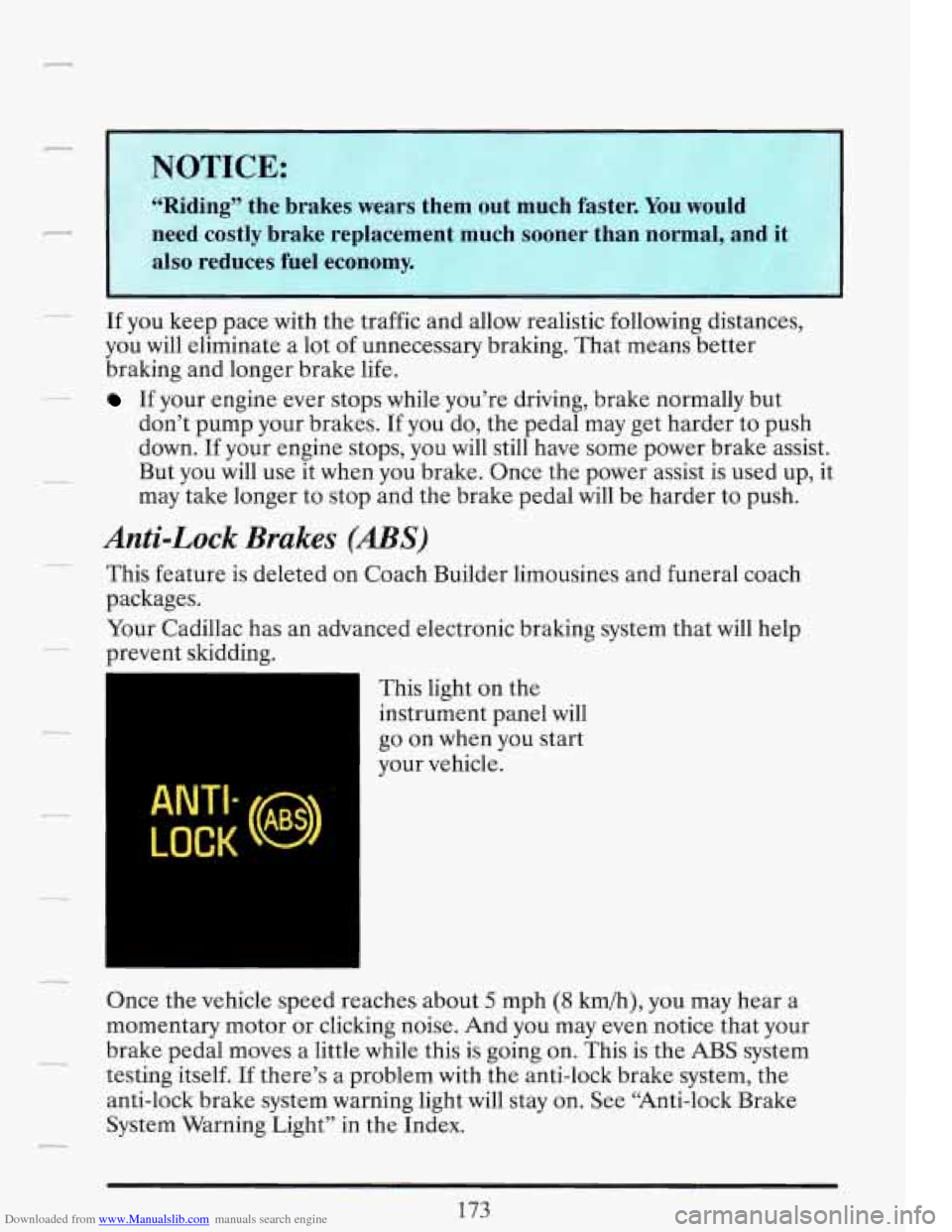
Downloaded from www.Manualslib.com manuals search engine If you keep pace with the traffic and allow realistic following distances,
you will eliminate a lot of unnecessary braking. That means better
braking and longer brake life.
If your engine ever stops while you’re driving, brake normally but
don’t pump your brakes.
If you do, the pedal may get harder to push
down.
If your engine stops, you will still have some power brake assist.
But you will use it when you brake. Once the power assist is used up, it
may take longer to stop and the brake pedal
will be harder to push.
Anti-Lock Brakes (ABS)
This feature is deleted on Coach Builder limousines and funeral coach
packages.
Your Cadillac has an advanced electronic braking system that will help
prevent skidding.
This light on the
instrument panel will
go
on when you start
your vehicle.
Once the vehicle speed reaches about
5 mph (8 km/h), you may hear a
momentary motor or clicking noise. And you may even notice that your
brake pedal moves a little while this is going on. This is the
ABS system
testing itself. If there’s
a problem with the anti-lock brake system, the
anti-lock brake system warning light will stay on. See “Anti-lock Brake
System Warning Light” in the Index.
173
Page 190 of 386
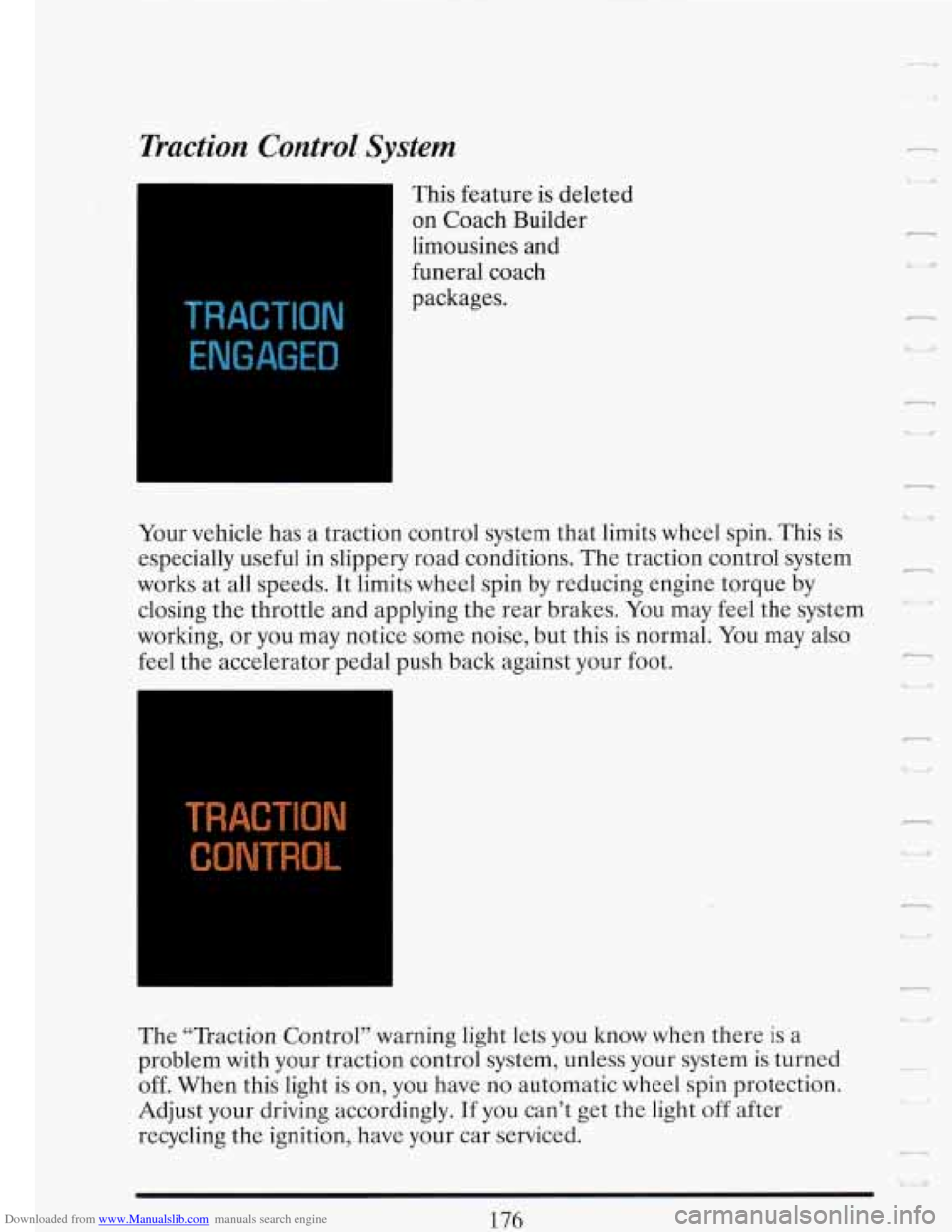
Downloaded from www.Manualslib.com manuals search engine Traction Control System
~ This feature is deleted
on Coach Builder
limousines and
funeral coach
packages. I
TRACTION
ENGAGED
Your vehicle has a traction control system that limits wheel spin. This is
especially useful in slippery road conditions. The traction control system
works at all speeds. It limits wheel spin by reducing engine torque by
closing the throttle and applying the rear brakes. You may feel the system
working, or you may notice some noise, but this is normal. You may also
feel the accelerator pedal push back against your foot.
I ~
i
TRACTION
I: I
The “Traction Control” warning light lets you know when there is a
problem with your traction control system, unless your system is turned
off. When this light is on,
you have no automatic wheel spin protection.
Adjust your driving accordingly. If you can’t get the light off after
recycling the ignition, have your car serviced.
n
u
c ‘I W
n
U
I
LrJ
-
L
..
r
1
L 7
I
UI
Page 191 of 386

Downloaded from www.Manualslib.com manuals search engine To limit wheel spin, especially in slippery road conditions, you should
always leave your traction control system on. But you can turn the
traction control system off
if you ever need to.
TRACTION
CONTROL
DISABLE
SWITCH
3
To turn the system off, press this switch. The “Traction Control” light will
come on and stay on. To turn the traction control system back on, you
must stop and turn off the ignition. Then restart the engine. The traction
control system automatically comes on whenever you start your vehicle.
-
Disc Brake Wear Indicators
Your Cadillac has front disc brakes and rear drum brakes.
-- Disc brake pads have built-in wear indicators that make a high-pitched
warning sound when the brake pads are worn and new pads are needed.
The sound may come and go or be heard all the time your vehicle is
.. - moving (except when you are pushing on the brake pedal firmly).
I
A CAUTION:
The brake wear warning sound means that sooner or later your
brakes won’t work well. That could lead to an accident. When
you hear the brake wear warning sound, have your vehicle
serviced. I
Page 192 of 386
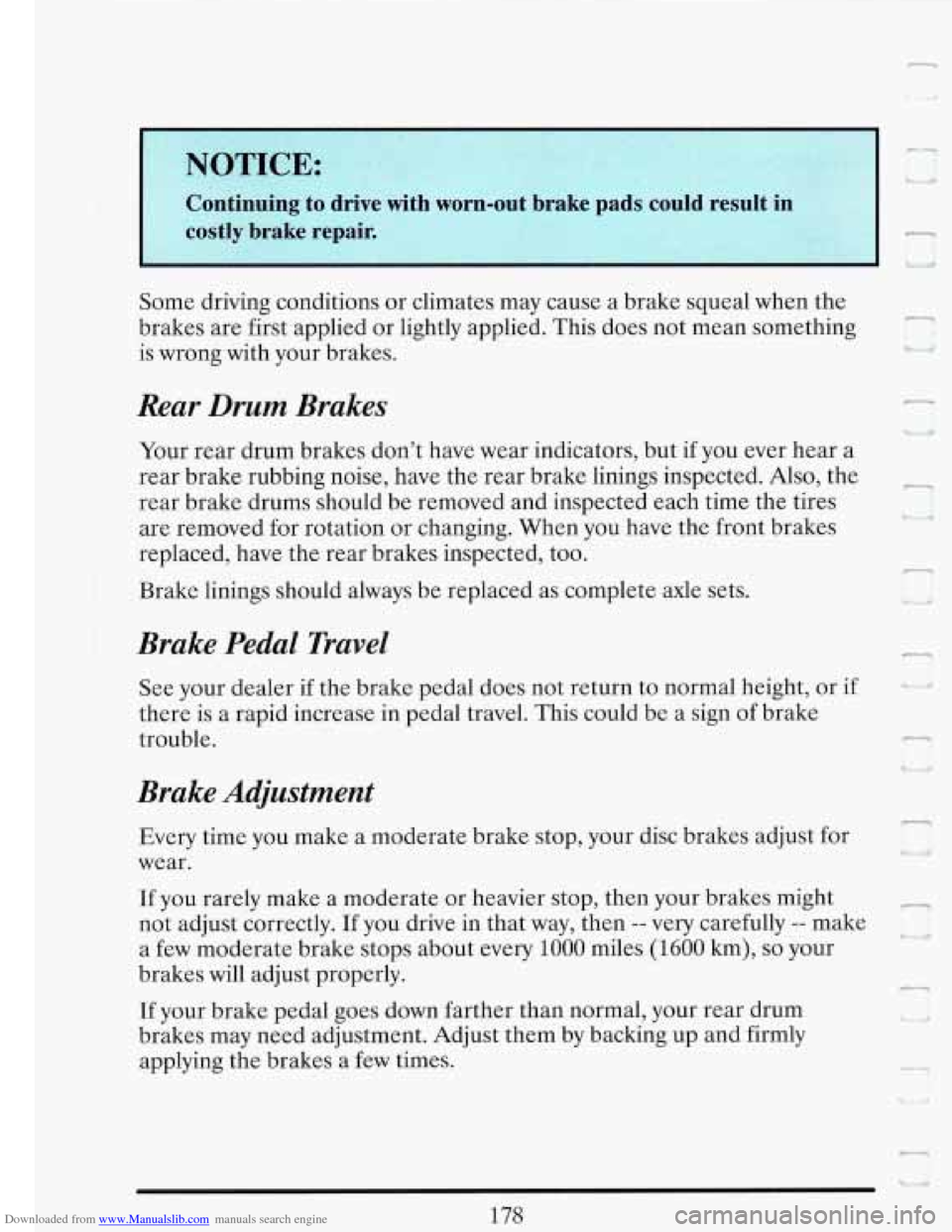
Downloaded from www.Manualslib.com manuals search engine IY OTICE:
-I
1
L
Continuing to drive with worn-out brake pads could result in
costly brake repair.
-
Some driving conditions or climates may cause a brake squeal when the
brakes are first applied or lightly applied. This does not mean something
is wrong with your brakes.
Rear Drum Brakes
F
c I
Your rear drum brakes don’t have wear indicators, but if you ever hear a
rear brake rubbing noise, have the rear brake linings inspected.
Also, the
rear brake drums should be removed and inspected each time the tires
are removed for rotation or changing. When you have the front brakes
replaced, have the rear brakes inspected,
too.
11
Brake linings should always be replaced as complete axle sets.
Brake Pedal Travel
See your dealer if the brake pedal does not return to normal height, or if c r
there is a rapid increase in pedal travel. This could be a sign of brake
trouble.
Brake Adjustment
Every time you make a moderate brake stop, your disc brakes adjust for
wear.
If you rarely make a moderate or heavier stop, then your brakes might
not adjust correctly. If you drive in that way, then
-- very carefully -- make
a few moderate brake stops about every
1000 miles (1600 km), so your -i
brakes will adjust properly.
,
-1
If your brake pedal goes down farther than normal, your rear drum
brakes may need adjustment. Adjust them
by backing up and firmly
applying the brakes a few times.
7
Page 194 of 386
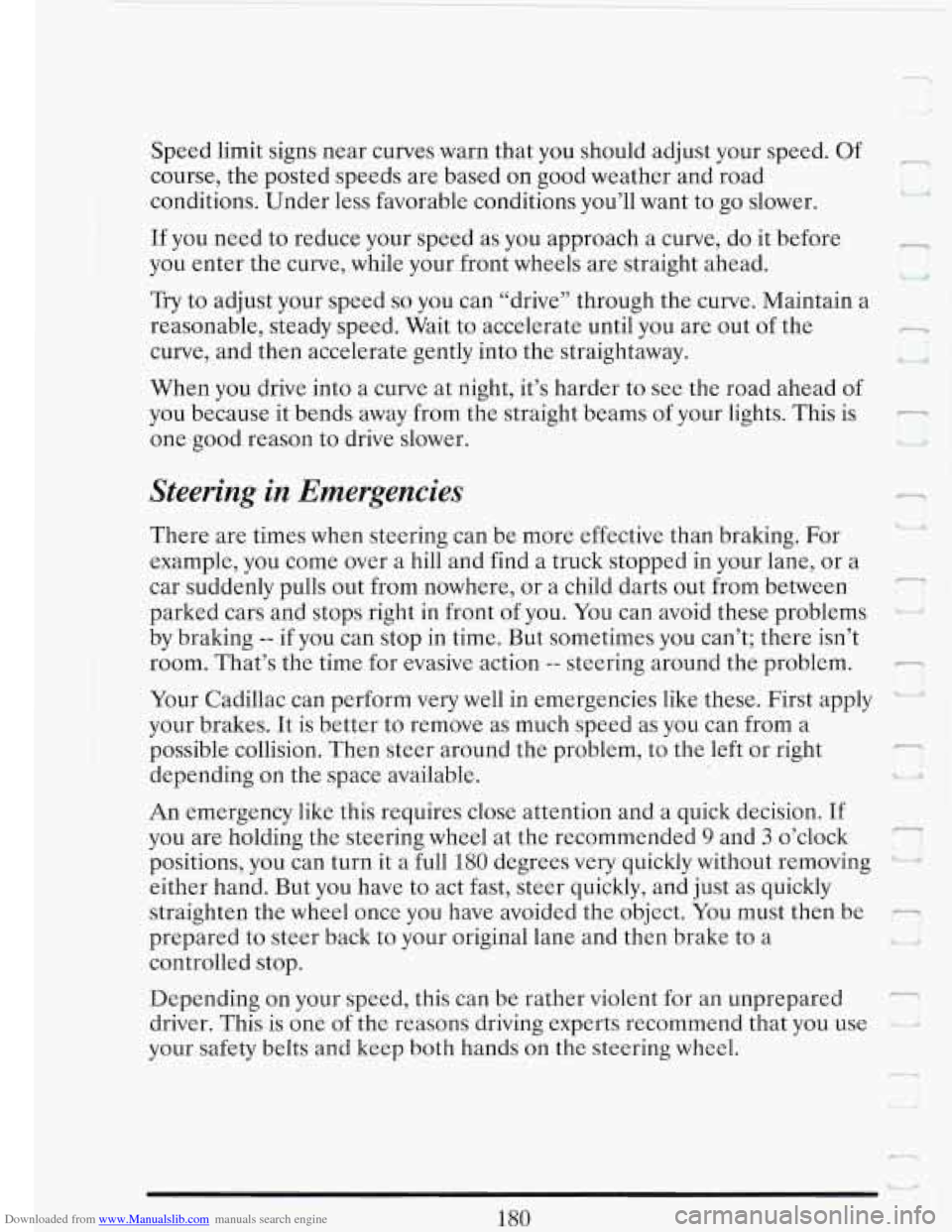
Downloaded from www.Manualslib.com manuals search engine c 1
Speed limit signs near curves warn that you should adjust your speed. Of
course, the posted speeds are based on good weather and road
conditions. Under less favorable conditions you’ll want to go slower.
If you need to reduce your speed as you approach a curve, do it before
you enter the curve, while your front wheels are straight ahead.
Try to adjust your speed so you can “drive” through the curve. Maintain a
reasonable, steady speed. Wait to accelerate until you are out of the
curve, and then accelerate gently into the straightaway.
When you drive into a curve at night, it’s harder to see the road ahead of
you because it bends away from the straight beams of your lights. This is
one good reason to drive slower.
n
cz;
n
Steering in Emergencies
There are times when steering can be more effective than braking. For
example, you come over a hill and find a truck stopped in your lane, or a
car suddenly pulls out from nowhere, or a child darts out from between
parked cars and stops right in front
of you. You can avoid these problems
by braking
-- if you can stop in time. But sometimes you can’t; there isn’t
room. That’s the time for evasive action
-- steering around the problem. -
-
Your Cadillac can perform very well in emergencies like these. First apply
your brakes. It is better to remove as much speed as you can from a
possible collision. Then steer around the problem, to the left or right
depending on the space available. I,
An emergency like this requires close attention and a quick decision. If
you are holding the steering wheel at the recommended
9 and 3 o’clock
positions, you can turn it a full
180 degrees very quickly without removing ‘ i’
either hand. But you have to act fast, steer quickly, and just as quickly
straighten the wheel once you have avoided the object. You must then be
-
7
prepared to steer back to your original lane and then brake to a
controlled stop.
Depending on your speed, this can be rather violent for an unprepared
driver. This is one of the reasons driving experts recommend that you use
your safety belts and keep both hands
on the steering wheel.
-1
r P
180